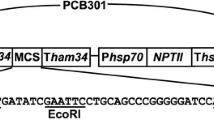Abstract.
Germinated asexual sporangia, zoospores, and mycelia of Phytophthora infestans were transformed to G418-resistance by microprojectile bombardment. After optimization, an average of 14 transformants/shot were obtained, using 106 germinated sporangia and gold particles coated with 1 µg of vector. Transformants displayed tandem or simple insertions of vector sequences within chromosomes. Most primary transformants were heterokaryons of transformed and wild-type nuclei, a state which generally persisted for generations, even with G418 selection. Transgenic homokaryons were easily obtained from primary transformants through G418 selection of zoospores. To facilitate the optimization of transformation, experiments were performed using a vector containing neomycin phosphotransferase (npt) and β-glucuronidase (GUS) genes fused to oomycete transcriptional regulatory sequences. To indicate which orientations of transgenes would maximize their expression, head-to-head, head-to-tail, or tail-to-tail orientations of npt and GUS were compared. Each yielded similar rates of transformation and levels of GUS activity, indicating little transcriptional interference.






Similar content being viewed by others
References
Bailey AM, Mena GL, Herrera-Estrella L (1993) Transformation of four pathogenic Phytophthora spp by microprojectile bombardment on intact mycelia. Curr Genet 23:42–46
Barreto CC, Alves LC, Aragao FJL, Rech E, Schrank A, Vainstein MH (1997) High frequency gene transfer by microprojectile bombardment of intact conidia from the entomopathogenic fungus Paecilomyces fumosoroseus. FEMS Microbiol Lett 156:95–99
Breyne P, Gheysen G, Jacobs A, Van Montagu M, Depicker A (1992) Effect of T-DNA configuration on transgene expression. Mol Gen Genet 235:389–396
Caten CE, Jinks JL (1968) Spontaneous variability in isolates of Phytophthora infestans. I. Cultural variation. Can J Bot 46:329–348
Cho SH, Chung YS, Cho SK, Rim YW, Shin JS (1999) Particle bombardment mediated transformation and GFP expression in the moss Physcomitrella patens. Mol Cells V9:14–19
Crabb BS, Triglia T, Waterkeyn JG, Cowman AF (1997) Stable transgene expression in Plasmodium falciparum. Mol Biochem Parasitol 90:131–144
Davis RH (1960) Adaptation in panthothenate-requiring Neurospora. 2. Nuclear competition during adaptation. Am J Bot 47:648–654
Fry WE, Goodwin SB (1997) Resurgence of the Irish potato famine fungus. Bioscience 47:363–371
Gavino PD, Smart CD, Sandrock RW, Miller JS, Hamm PB, Lee TY, Davis RM, Fry WE (2000) Implications of sexual reproduction for Phytophthora infestans in the United States: generation of an aggressive lineage. Plant Dis 84:731–735
Gisi U, Cohen Y (1996) Resistance to phenylamide fungicides: a case study with Phytophthora infestans involving mating type and race structure. Annu Rev Phytopathol 34:549–572
Greger IH, Aranda A, Proudfoot NJ (2000) Balancing transcriptional interference and initiation on the GAL7 promoter of Saccharomyces cerevisiae. Proc Natl Acad Sci USA 97:122–123
Guo Z, Yang NS, Jiao S, Sun J, Cheng L, Wolff JA, Duncan ID (1996) Efficient and sustained transgene expression in mature rat oligodendrocytes in primary culture. J Neurosci Res 43:31–41
Herzog RW, Daniell H, Singh NK, Lemke PA (1996) A comparative study on the transformation of Aspergillus nidulans by microprojectile bombardment of conidia and a more conventional procedure using protoplasts treated with polyethylene glycol. Appl Microbiol Biotechnol 45:333–337
Hilber UW, Bodmer M, Smith FD, Koller W (1994) Biolistic transformation of conidia of Botryotinia fuckeliana. Curr Genet 25:124–127
Judelson HS, Whittaker SL (1995) Inactivation of transgenes in Phytophthora infestans is not associated with their deletion, methylation, or mutation. Curr Genet 28:571–579
Judelson HS, Yang GE (1998) Recombination pathways in Phytophthora infestans: polyploidy resulting from aberrant sexual development and zoospore-mediated heterokaryosis. Mycol Res 102:1245–1253
Judelson HS, Tyler BM, Michelmore RW (1991) Transformation of the oomycete pathogen, Phytophthora infestans. Mol Plant-Microbe Interact 4:602–607
Judelson HS, Dudler R, Pieterse CMJ, Unkles SE, Michelmore RW (1993) Expression and antisense inhibition of transgenes in Phytophthora infestans is modulated by choice of promoter and position effects. Gene 133:63–69
Kamoun S, Hraber P, Sobral B, Nuss D, Govers F (1999) Initial assessment of gene diversity for the oomycete pathogen Phytophthora infestans based on expressed sequences. Fungal Genet Biol 28:94–106
Lucau-Danila A, Wysocki R, Roganti T, Foury F (2000) Systematic disruption of 456 ORFs in the yeast Saccharomyces cerevisiae. Yeast 16:547–552
Maenpaa P, Gonzalez EB, Ahlandsberg S, Jansson C (1999) Transformation of nuclear and plastomic plant genomes by biolistic particle bombardment. Mol Biotechnol 13:67–72
Maltese CE, Conigliaro G, Shaw DS (1995) The development of sporangia of Phytophthora infestans. Mycol Res 99:1175–1181
Raeder U, Broda P (1985) Rapid preparation of DNA from filamentous fungi. Lett Appl Microbiol 1:17–20
Ramsdale M, Rayner ADM (1996) Imbalanced nuclear ratios, post-germination mortality and phenotype–genotype relationships in allopatrically derived heterokaryons of Heterobasidion annosum. New Phytol 133:303–319
Schöpke C, Fauquet CM (1999) Introduction of materials into living cells. Oxford University Press, New York
Tyler BM (2001) Genetics and genomics of the oomycete–host interface. Trends Genet 17:611–614
Van West P, Kamoun S, Van't Klooster JW, Govers F (1999) Internuclear gene silencing in Phytophthora infestans. Mol Cell 3:339–348
Whittaker SL, Shattock RC, Shaw DS (1992) The duplication cycle and DAPI-DNA contents in nuclei of germinating zoospore cysts of Phytophthora infestans. Mycol Res 96:355–358
Acknowledgements.
This work was supported by grants from Syngenta, the University of California BioSTAR program, the National Science Foundation of the United States, and the United States Department of Agriculture, and by a travel grant to C.C. from the Danish Natural Science Research Council.
Author information
Authors and Affiliations
Corresponding author
Additional information
Communicated by U. Kück
Rights and permissions
About this article
Cite this article
Cvitanich, C., Judelson, H.S. Stable transformation of the oomycete, Phytophthora infestans, using microprojectile bombardment. Curr Genet 42, 228–235 (2003). https://doi.org/10.1007/s00294-002-0354-3
Received:
Revised:
Accepted:
Published:
Issue Date:
DOI: https://doi.org/10.1007/s00294-002-0354-3




